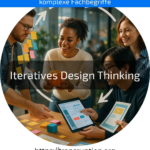Iterative design thinking is particularly at home in the areas of digital transformation, HR work and teams as well as eCommerce and digital commerce. It describes a modern approach in which new products, services or processes are improved step by step. "Iterative" means that something is constantly reviewed, adapted and tested again - a kind of "try and learn".
The user takes centre stage: ideas are quickly sketched out, prototypes are built and tested with real users. The solutions are then continuously improved based on the feedback. The aim is not to start with a perfect end product, but to quickly find out what really works by making lots of small improvements.
An illustrative example: An online shop wants to improve the shopping experience. A simple new search function is first tested using iterative design thinking. Customers use it and provide feedback. Based on this, the search is revised again - for example, because users cannot find the filters. This process is repeated several times until the search function is optimised for the user. The result is a solution that is really needed and is used with pleasure.






